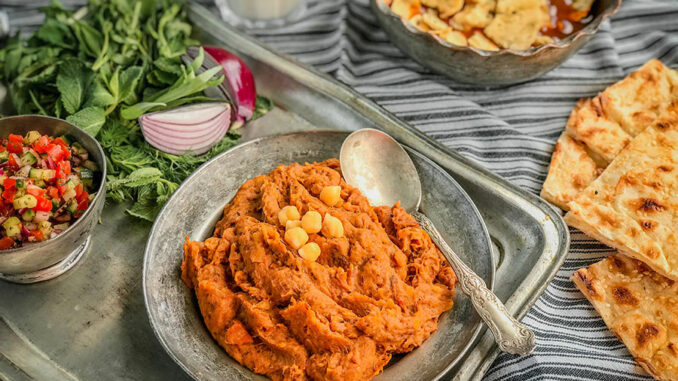
Abgoosht, also known as Dizi, is a traditional Persian lamb stew that has been enjoyed for centuries in Iran and neighboring regions. This hearty and flavorful dish is cherished for its rich broth, tender meat, and comforting aromas, making it a favorite choice for family gatherings, celebrations, and cold winter days. In this comprehensive guide, we’ll delve into the origins of Abgoosht, explore its cultural significance, and provide a detailed recipe to recreate this beloved Persian dish at home.
History and Cultural Significance
The history of Abgoosht can be traced back to ancient Persia, where it was a staple dish enjoyed by people of all backgrounds and social classes. The word “Abgoosht” translates to “meat broth” in Persian, highlighting the dish’s primary components: tender lamb meat cooked in a flavorful broth with a variety of vegetables and legumes.
Abgoosht has deep roots in Persian culinary tradition and reflects the country’s rich agricultural heritage and diverse culinary influences. Over the centuries, Abgoosht has evolved and adapted to various regional preferences and ingredients, resulting in a wide array of regional variations and family recipes.
Beyond its culinary appeal, Abgoosht holds cultural significance for Iranians, serving as a symbol of hospitality, warmth, and shared traditions. It is often prepared for special occasions such as weddings, Nowruz (Persian New Year), and family gatherings, where it is enjoyed with delight and shared among loved ones.
Recipe for Abgoosht
Now, let’s explore a traditional recipe for Abgoosht, featuring tender lamb, a medley of vegetables, and fragrant spices:
Ingredients:
- 2 lbs (900g) lamb shoulder or shank, cut into large chunks
- 1 onion, finely chopped
- 3 cloves garlic, minced
- 2 large tomatoes, chopped
- 2 large potatoes, peeled and quartered
- 2 large carrots, peeled and cut into chunks
- 1 cup dried chickpeas, soaked overnight
- 1 cup dried white beans, soaked overnight
- 1/2 cup dried split peas, soaked overnight
- 1/4 cup dried fenugreek leaves (optional)
- 1 teaspoon ground turmeric
- 1 teaspoon ground cumin
- 1/2 teaspoon ground cinnamon
- Salt and pepper to taste
- 8 cups water
- Fresh herbs (such as parsley, cilantro, or mint) for garnish
- Lavash or flatbread for serving
Instructions:
- In a large pot, combine the lamb chunks, chopped onion, minced garlic, chopped tomatoes, soaked chickpeas, soaked white beans, soaked split peas, dried fenugreek leaves (if using), ground turmeric, ground cumin, ground cinnamon, salt, and pepper.
- Pour 8 cups of water over the ingredients in the pot, ensuring that they are fully submerged. Bring the mixture to a boil over high heat, then reduce the heat to low and let it simmer, covered, for 2-3 hours, or until the lamb is tender and the beans and chickpeas are cooked through.
- Once the lamb and legumes are cooked, use a slotted spoon to remove the lamb chunks from the pot and transfer them to a separate bowl. Use a fork to shred the lamb meat into smaller pieces, discarding any bones or excess fat.
- Return the shredded lamb meat to the pot, along with the quartered potatoes and chopped carrots. Continue to simmer the stew, covered, for an additional 30-45 minutes, or until the potatoes and carrots are tender.
- Once the vegetables are cooked, use a potato masher or the back of a spoon to mash some of the vegetables and legumes against the side of the pot. This will help thicken the broth and create a creamy texture.
- Taste the stew and adjust the seasoning with salt and pepper as needed. If the stew is too thick, you can add more water to reach your desired consistency.
- To serve, ladle the hot Abgoosht into individual bowls and garnish with fresh herbs. Serve with lavash or flatbread on the side for dipping.
Tips for Perfect Abgoosht:
- Soaking the dried chickpeas, white beans, and split peas overnight helps to soften them and reduce the cooking time.
- Feel free to customize the vegetables and legumes used in the stew according to your preferences. Other options include butternut squash, turnips, or kidney beans.
- Adding dried fenugreek leaves (shanbalileh) to the stew adds a unique flavor and aroma, but it can be omitted if unavailable.
- For a richer and more flavorful broth, you can use lamb broth or stock instead of water.
- Abgoosht is traditionally served with lavash or flatbread for dipping, but you can also enjoy it with rice or couscous on the side.
Conclusion
Abgoosht is more than just a dish; it’s a culinary journey that transports you to the heart of Persian culture and tradition. With its tender lamb, hearty legumes, and aromatic spices, Abgoosht captivates the senses and nourishes the soul, offering a taste of the rich culinary heritage of Iran. Whether enjoyed at a festive celebration or a cozy family dinner, Abgoosht brings people together to savor the flavors of tradition and the warmth of shared memories. With its timeless appeal and comforting aromas, Abgoosht continues to delight food enthusiasts around the world, offering a glimpse into the rich tapestry of Persian cuisine.